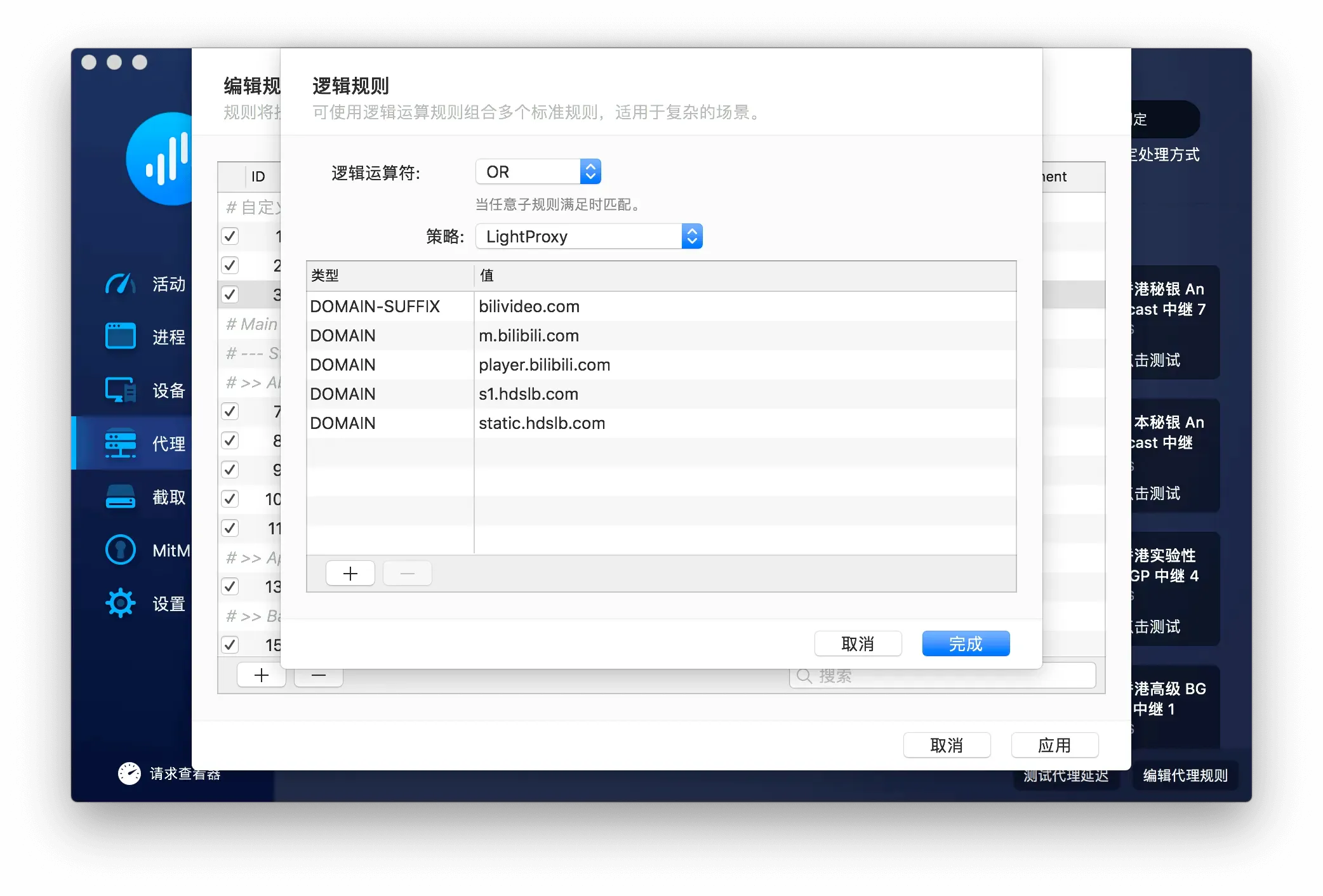前端经常需要一些特殊的调试环境,这时有一个科学的 Web 调试代理工具(以下称代理工具)显得尤其重要
我用的第一个代理工具是 Charles,功能多但缺点也很明显,笨重、配置麻烦,爬
后来换到了 Zan Proxy
Zan Proxy 是一个 Node.js 编写的代理工具,跟大杂烩 Charles 不一样,专注于 Web 调试,轻量、配置方便,虽然功能很简单,但对我来说够用了
配置都是在一个 Web 页进行,界面很舒服,我用它做一些简单的转发请求、修改响应头、mock 数据

但随着工作内容的发展,需要的调试环境也越来越复杂,Zan Proxy 已经慢慢不能满足我的需求
LightProxy 适时地出现在了我的视野

LightProxy 是一款基于 whistle 的本地代理抓包软件(其实直接用 whistle 也差不多
下面通过一些我自己使用的规则来介绍它
请求转发
player.bilibili.com http://127.0.0.1:8080
^*s1.hdslb.com/bfs/static/player/main/video*.js file:///Users/diygod/Code/bilibili/js-common/packages/video/dist/release/video.js
^*s1.hdslb.com/bfs/static/player/main/video*.js.map file:///Users/diygod/Code/bilibili/js-common/packages/video/dist/release/video.js.map(1)项目接口和 CDN 都被限制某些域名可以用,所以需要这样一个东西做开发环境
比用 webpack 开一个 80 端口的 server 再绑 hosts 优雅 80 倍
(2)可以用来代理线上文件
把本地编译好的项目文件代理到真实线上环境,这里用到了通配符来匹配路径
修改响应内容
m.bilibili.com resAppend://`
<script src="https://cdn.jsdelivr.net/npm/eruda"></script>
<script>eruda.init();</script>
`修改移动端页面的响应内容,让页面加载调试工具 Eruda,方便移动端调试
值得一提的是 whistle 有个很神经病的地方,whistle 本身并不支持这样的行内写法,需要很麻烦地在另一个面板设置 {key} 或者使用本地文件
所以 LightProxy 做了一层转义,把行内代码保存成了一个临时文件,打开 whistle 可以看到实际发给 whistle 的配置是类似这样的
m.bilibili.com resAppend:///var/folders/_l/hbcxcqh522s_vls68417h2m40000gn/T/lightproxy/0-152.txt修改响应头
/.*bilivideo\.com\/.*300(\d){2}\.m4s/ resHeaders://`{
'x-service-module': 'test-video'
}`
/.*bilivideo\.com\/.*302(\d){2}\.m4s/ resHeaders://`{
'x-service-module': 'test-audio'
}`
/.*bilivideo\.com\/.*\.flv/ resHeaders://`{
'x-service-module': 'test-flv'
}`这里用了正则来给不同类型的文件匹配不同的规则
修改 cookie
m.bilibili.com/video/ resCookies://`{
ab: '0000test',
}`在移动端修改 cookie 并不是那么方便,所以我用了这个规则,本质上是修改响应头的 Set-Cookie
host 转发
172.22.33.166 s1.hdslb.com player.bilibili.com static.hdslb.com除了支持各种匹配模式,还支持传统 hosts 语法规则,SwitchHosts 可以扔掉了
模拟网络异常
*.bilivideo.com replaceStatus://403 includeFilter://m:get
*.bilivideo.com resSpeed://2000
*.bilivideo.com resDelay://3000各种模拟网络异常的功能深深戳中了我的痛点
例子中的 *.bilivideo.com 匹配 bilibili 视频 CDN 地址
(1)模拟 CDN 状态码,用来调试 CDN 地址超时或异常,没有 LightProxy 的日子里只能在代码里 mock 或很蠢地等很久等视频地址超时
(2)模拟慢速,用来调试卡顿或自动清晰度切换,可以用来代替 Chrome Network Throttling
(3)模拟 CDN 请求超时,用来调试 CDN 拉流超时,没有 LightProxy 的时候只能小心翼翼地控制 Chrome Network Throttling,太小了会导致请求失败,太大了超时又不够长
Node.js 规则
LightProxy 还有一个很酷的功能,使用 Node.js 书写规则,以下是官方的一个 demo,我暂时还没有这个功能的使用场景,但就是感觉很酷
github.com/alibaba/lightproxy scriptfile://`
exports.handleRequest = async (ctx, next) => {
// do sth
// ctx.fullUrl 可以获取请求url
// ctx.headers 可以获取请求头
// ctx.options 里面包含一些特殊的请求头字段,分别可以获取一些额外信息,如请设置的规则等
// ctx.method 获取和设置请求方法
// const reqBody = await ctx.getReqBody(); 获取请求body的Buffer数据,如果没有数据返回null
// const reqText = await ctx.getReqText(); 获取请求body的文本,如果没有返回''
// const formData = await ctx.getReqForm(); 获取表单对象,如果不是表单,返回空对象{}
// ctx.req.body = String| Buffer | Stream | null,修改请求的内容
// next方法可以设置next({ host, port });
// 只有执行next方法后才可以把正常的请求发送出去
const { statusCode, headers } = await next();
// do sth
// const resBody = yield ctx.getResBody();
// const resText = yield ctx.getResText();
// ctx.status = 404; 修改响应状态码
// ctx.set(headers); 批量修改响应头
// ctx.set('x-test', 'abc'); 修改响应头
// ctx.body = String| Buffer | Stream | null; 修改响应内容
ctx.body = 'test';
};`从以上例子中相信大家已经对 LightProxy / whistle 的用法有了自己的理解
最后还有一个值得一提的事情是,用了这些调试代理工具之后魔法上网怎么办?
调试和魔法上网用的是不同的代理,我是一个面向 Google 编程的人,代理一直切来切去太麻烦,我的做法是系统代理交给 Surge 接管,利用 Surge 分流,新建一个 LightProxy 代理,然后编辑 Surge 规则,只把需要调试的请求分给 LightProxy


以上就是我目前的 Web 调试代理实践